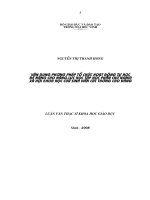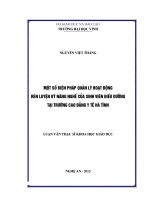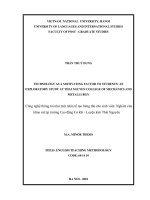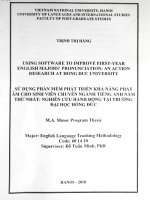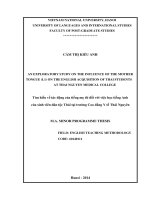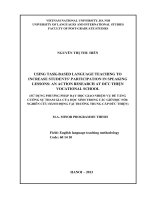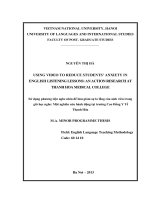Sử dụng phương tiện nghe nhìn để làm giảm sự lo lắng của sinh viên trong giờ học nghe Một nghiên cứu hành động tại trường Cao Đẳng Y Tế Thanh Hóa
Bạn đang xem bản rút gọn của tài liệu. Xem và tải ngay bản đầy đủ của tài liệu tại đây (576.16 KB, 74 trang )
VIETNAM NATIONAL UNIVERSITY, HANOI
UNIVERSITY OF LANGUAGES AND INTERNATIONAL STUDIES
FACULTY OF POST- GRADUATE STUDIES
NGUYỄN THỊ HÀ
USING VIDEO TO REDUCE STUDENTS’ ANXIETY IN
ENGLISH LISTENING LESSONS: AN ACTION RESEARCH AT
THANH HOA MEDICAL COLLEGE
Sử dụng phương tiện nghe nhìn để làm giảm sự lo lắng của sinh viên trong
giờ học nghe: Một nghiên cứu hành động tại trường Cao Đẳng Y Tế
Thanh Hóa
M.A. MINOR PROGRAMME THESIS
Field: English Language Teaching Methodology
Code: 60 14 10
Ha Noi – 2013
VIETNAM NATIONAL UNIVERSITY, HANOI
UNIVERSITY OF LANGUAGES AND INTERNATIONAL STUDIES
FACULTY OF POST- GRADUATE STUDIES
NGUYỄN THỊ HÀ
USING VIDEO TO REDUCE STUDENTS’ ANXIETY IN
ENGLISH LISTENING LESSONS: AN ACTION RESEARCH AT
THANH HOA MEDICAL COLLEGE
Sử dụng phương tiện nghe nhìn để làm giảm sự lo lắng của sinh viên trong
giờ học nghe: Một nghiên cứu hành động tại trường Cao Đẳng Y Tế
Thanh Hóa
M.A. MINOR PROGRAMME THESIS
Field: English Language Teaching Methodology
Code: 60 14 10
Supervisor: Dr. Lê Văn Canh
Ha Noi – 2013
iv
TABLE OF CONTENTS
DECLARATION i
ACKNOWLEDGEMENTS ii
ABSTRACT iii
TABLE OF CONTENTS iv
LIST OF FIGURES, TABLES AND CHARTS v
LIST OF ABBREVIATION vi
CHAPTER 1: INTRODUCTION 1
1.1. Statement of the problem and rationale of the study 1
1.2. Research Aims and Research Questions 2
1.3. Significance of the study 2
1.4. Scope of the study 2
1.5. Design of the study 3
CHAPTER 2: LITERATURE REVIEW 4
2.1. Overview of anxiety and listening anxiety 4
2.1.1. Anxiety 4
2.1.2. Anxiety in listening comprehension 6
2.1.3. Causes of listening anxiety 7
2.1.4. Effects of FLA on listening comprehension 8
2.2. Definition and benefits of using videos in learning English in general and in
learning listening skill in particular 9
2.3. Previous studies 12
CHAPTER 3: METHODOLOGY 14
3.1. Action Research 14
3.1.1. What is action research? 14
3.1.2. Rationale for the use of an action research 15
3.2. The context of teaching and learning listening skill at THMC 17
3.3. Participants 17
3.4. Classroom setting 18
v
3.5. Instruments 18
3.5.1. Interviews 18
3.5.2. Questionnaires 19
3.5.3. Diaries 19
3.6. Research procedure 20
3.7. Research program 22
3.8. Data collection procedure 22
3.9. Data analysis procedure 23
CHAPTER 4: RESEARCH FINDINGS AND DISCUSSION 24
4.1. Students‟ initial attitude to listening skill 24
4.2. Possible explanations for the students‟ listening anxiety 25
4.3. Changes in students attitude toward listening skill after using video 26
4.4. Impacts of video- based instruction on reducing students‟ anxiety in doing
listening comprehension tasks 28
4.4.1. Video as a useful tool to solve the causes of the students‟ anxiety 28
4. 4.2. Changes in students‟ perceived learning (understanding and retention ) and
performance……………………………………… ……….……… ………….29
4.4.3. Students‟ preference in doing listening activities 31
4.4.4. Students‟ preference toward video techniques used by the teacher in listening lessons 33
4.4.5. Students‟ assessment on the role of video 34
CHAPTER 5: CONCLUSIONS 37
5.1. Major findings and discussion of the research 37
5.2. Conclusion 38
5.3. Objective revisited 39
5.4. The limitations of the research 39
5.5. Suggestion for further studies 40
REFERENCE 41
APPENDICES I
vi
LIST OF FIGURES, TABLES AND CHARTS
Tables
Table 1: Students‟ attitude toward listening before using video
Table 2: Students‟ anxiety in listening lesson without video
Table 3: The causes of the students‟ anxiety in the listening lessons
Table 4: Students‟ attitude toward listening after using video
Table 5: Students‟ anxiety in listening lesson using video
Table 6: Students‟ preference in doing listening activities
Table 7: Students‟ preference toward video techniques used by the teacher in listening
lessons
Figures
Figure 1: Change in percentage of students‟ comprehension after using video
Figure 2: Change in percentage of students‟ retention after using video
Pie charts
Chart 1: Students‟ assessment on the importance of video
Chart 2: Students‟ assessment on effectiveness of video material
vii
LIST OF ABBREVIATIONS
TMC: Thanh Hoa Medical College
L1: first language
L2: second language
ULIS: University of Language and International Studies
IT: Information Technology
Ss: students
ESP: English for special purpose
FLA: Foreign Language Anxiety
LC : Listening Comprehension
1
CHAPTER 1: INTRODUCTION
1.1. Statement of the problem and rationale of the study
Recently, technology has been recommended to be used in education with a view of
providing learners with more learning opportunities. Videos are among the
technologies that are believed to have significant influences on second or foreign
language learning. This type of technology is said to allow teacher to create
virtually the target language environment into classroom so that live or prerecorded
news, music, sports from all over the world can be viewed by students in real time.
The advantages of using video in the language classroom have been recognized by
many researchers in applied linguistics. The main advantage of using video as a
technology for language teaching is considered to be its ability to present and
immerse learners into complete communicative situations (Lonergan, 1984).
Another important advantage is the ability of video to cover non-verbal aspects of
communication and its cross-cultural comparison potential (Stempleski & Tomalin,
1990). In addition, using video in the classroom allows differentiation of teaching
and learning according to students‟ abilities, learning styles and personalities.
Despite those benefits to language learners, the issue of how videos help to reduce
the students‟ listening anxiety is not yet adequately explored. As a teacher I believe
that anxiety inhibits students‟ participation in the learning processes, which affects
negatively the students‟ acquisition of the target language. Listening comprehension
in foreign language learning causes a lot of anxiety among learners because of a
variety of reasons. Therefore, efforts should be made to reduce the student anxiety
as the first step towards a more learner- centered approach to foreign language
teaching.
One of the reasons that causes students‟ listening anxiety is that while listening to
the recorded messages, students cannot see the speaker‟ face. This makes it
impossible for them to use the non-linguistic cues such as facial expressions and
other gestures to comprehend the speaker‟s message. By using the video to visualize
2
the speakers and the communication settings, I believe that the teacher can help
students to feel less anxious in doing the listening tasks. This is the rationale for
this present study.
1.2. Research Aims and Research Questions
This action research is aimed to explore the impact of the teacher‟s use of videos on
students‟ listening anxiety. To be specific, it is intended to gain understanding of the
extent to which the use of videos helps to reduce students‟ listening anxiety. So, the
study is to find answers to the following research questions:
Question 1: To what extent does the use of video in teaching listening change
the attitude of second year English non-majors toward learning listening skill?
Question 2: To what extent do the students’ changed attitudes to learning help to
reduce their anxiety in doing listening comprehension tasks?
1.3. Significance of the study
Although listening skill has always been given a significant in language teaching,
the questions of how to teach and learn listening skill effectively often pose great
problems to both teachers and students. This study primarily explores how the use
of videos instruction reduces students‟ anxiety at THMC. It also serves as a
valuable resource for teachers to gain a deep insight into the practice of video
instruction at the college. More importantly, an inventory of videos especially
videos about medicine are very useful for nursing students. Because medical words
are difficult and practical environments are not available. Videos can help them to
understand the lesson, help them to be confident when performing listening tasks.
Placing second-year students majoring in nursing at the centre of analysis, the study
intends to help the population to succeed in improving listening comprehension. On
an other hand, the study can be beneficial to teachers of English at other colleges,
who may undergo the same context of teaching and learning this skill.
1.4. Scope of the study
As an action research study, the study reported here is limited itself to the
exploration of the extent to which the use of videos in teaching listening
3
comprehension helps to reduce their listening anxiety, thereby changing their
attitudes towards listening comprehension. I believe that once the students feel more
self-confident in listening comprehension and they have a positive attitude towards
listening comprehension they will learn English better. After all, nobody can learn a
foreign language well without the ability to understand the spoken language. The
results of this study will be used to deepen my understanding of how to use
technology to reduce the my own students‟ learning anxiety. I do not intend to
investigate other aspects of technology or the impact of video-based listening
instruction on students‟ listening comprehension performance although this could
be the focus of the second cycle of this action research project.
1.5. Design of the study
This study is divided into five chapters:
Chapter 1, INTRODUCTION, presents the research problem and rationale of the
study, the aims, scope, significance, methods as well as the design of the study.
Chapter 2, LITERATURE REVIEW, deals with the theories involving anxiety in
listening comprehension and the need of using video in listening comprehension.
Chapter 3, METHODOLOGY, presents the methodology applied in the study
including participants, instrumentation, research process.
Chapter 4, RESEARCH FINDINGS AND DISCUSSION, presents the results of the
research and data analysis, from which major findings are revealed and discussed.
Chapter 5, CONCLUSIONS, reviews the major findings and give conclusions,
revises objectives and indicates some limitations of the study. And discussion and
suggestions for further study are put forward.
4
CHAPTER 2: LITERATURE REVIEW
This chapter gives an overview of the literature in which key concepts, theories and
previous studies in the field are presented.
2.1. Overview of anxiety and listening anxiety
2.1.1. Anxiety
Anxiety is quite possibly the affective factor that most pervasively obstructs the
learning process. It is associated with negative feelings such as uneasiness,
frustration, self-doubt, apprehension and tension. Heron (1989:33) makes
reference to what he terms existential anxiety, which arises out of a group
situation and has three interconnected components that are relevant to the
language classroom: “Acceptance anxiety. Will I be accepted, liked, wanted?
Orientation anxiety. Will I understand what is going on? Performance anxiety. Will
I be able to do what I have come to learn?”
For acquisition to take place, the learner has to be able to absorb the appropriate
parts of the input. There can be “a mental block that prevents acquirers from fully
utilizing the comprehensible input they receive for language acquisition” (Krashen,
1985, p.3). This block, called “ the affective filter”, might be because “ the acquirer
is unmotivated, lacking in self-confidence, or anxious” (Krashen, 1985, p.3). The
Affective Filter Hypothesis ascribes variation between learners to their
psychological states. If the filter is “ up”, comprehensible input cannot get through;
if it is “ down”, they can make effective use of it. In particular the reason why
younger learners are better at L2 acquisition over the long term is that “ the
affective filter gains dramatically in strength at around puberty” (Krashen, 1985,
p.13). Older learners are cut off from proper access to comprehensible input by the
increased strength of the filter. In Krashen‟s words, “ comprehensible input and
the strength of the filter are the true causes of second language acquisition”
(Krashen, 1982, p.33), one positively, one negatively.
5
There are few, if any, disciplines in the curriculum which lay themselves
open to anxiety production more than foreign or second language learning. There
is a great deal of vulnerability involved in trying to express oneself before others in
a shaky linguistic vehicle. It is possible in some cases that the methodology used
can contribute to furthering anxiety. With the grammar-translation method one
might assume a reduction of the possibility of anxiety, since the learners have
relatively little of themselves invested in the activities required. However, with
the advent of methods which focus on communication, and especially communication
involving more personal aspects of one‟s being, such as feelings, if care is not
taken to provide emotionally safe atmosphere, the chance for the development
of anxiety provoking situations can increase greatly. This is particularly true if at
the same time the stakes involved are very high, such as academic settings,
where the evaluation of the learner can conceivably have far-reaching
consequences. When anxiety is present in the classroom, there is a down- spiraling
effect. Anxiety makes us nervous and afraid and thus contributes to poor
performance; this in turn creates more anxiety and even worse performance. The
feelings of fear and nervousness are intimately connected to the cognitive side of
anxiety, which is worry. Worry wastes energy that should be used for memory and
processing on a type of thinking which in no way facilitates the task at hand
(Eysenck 1979). Although it is a major obstacle to language learning, anxiety can be
reduced.
Learners may suffer from anxiety in relation to a number of aspects of the teaching-
1earning process; for example, about the language itself, about speaking in front
of other learners, about the language class, about the behavior of their peers,
about their standing in the competition with fellow learners, about taking tests,
about the speakers of the language they are learning, etc. The more anxious they
are, the less well they believe they can perform. Classroom anxiety became extreme
for the student with the lowest proficiency. Each class presented new challenges and
the anxiety seemed to be debilitating. It is helpful for teachers to understand the
6
pressures felt by learners in the classrooms. Foss and Reitzel suggested that
knowledge and skills can best be dealt with through role play, drama, and oral
interpretation. Through performing the works of others, thoroughly rehearsed in
terms of both verbal and non-verbal language, the students experience less
communication anxiety than if they themselves must generate their own target
language utterances.
2.1.2. Anxiety in listening comprehension
Listening as the most frequently used skill plays an important role in foreign
language learning (Vogely, 1998) since through this channel learner is able to
comprehend the information. The importance of listening comprehension for
achieving success in language learning has been emphasized by both instructors and
students (Ferris & Tagg, 1996; Ferris, 1998). However, as Scarcella and Oxford
(1992) and Vogely (1999) stated anxiety can be highly provoked in listening
comprehension context. MacIntyre (1995) explained the reason for such an anxiety
is that learners often worry about misunderstanding what they listen to and the fear
of being embarrassed by interpreting the message wrongly (Chastain, 1979).
Research in foreign or second language learning has begun to show that anxiety
directly undermines motivation and creates a negative affective response to the
foreign language being studied (Gardner et al. 1987). Therefore, addressing foreign
language listening comprehension anxiety is fast becoming a priority in the
classroom.
Gonen (2009) mentioned that the authenticity of the listening text, incomprehensibility of the
listening material and other external environmental factors such as noise and inaudibility
can create anxiety among L2 learners.
However Dunkel (1991) believes that those students who do not have the
confidence might experience anxiety more. In a study done by Vogely (1998),
students reported the cause of their anxiety on being more concentrated on the
nature of speed, level of difficulty, ambiguity, lack of visual support and lack of
repetition. Kim (2000) in her study analyzed foreign language anxiety scale and
7
concluded that lack of confidence and being worried over listening are the main
reasons of anxiety in L2 learners. Moderate negative correlation between listening
anxiety and listening proficiency was another finding of her study. In another study
conducted by Chang (2008) English learners‟ listening anxiety was higher than their
speaking anxiety and this anxiety was more significant in testing situation rather
than class environment.
According to Scarcella and Oxford (1992), listening anxiety occurs when students
feel they are faced with a task that is too difficult or unfamiliar to them. This
anxiety is exacerbated if the listeners are under the false impression that they must
understand every word they hear. Many learners believe that in order to be “good at
a language they need perfect pronunciation, massive amounts of vocabulary,
extensive grammar knowledge, overseas experience, and a natural aptitude for
language before they even open their mouths (Horwitz1986). As a result, the
anxiety that arises during the listening process often springs form what Joiner
(1986) calls a negative “listening self-concept,” that is, a low level of self-
confidence in the area of listening.
Gardner and MacIntyre (1995) show that the most negative element that
influences the language performance is anxiety. LC anxiety can undermine
speech production because, in order to interact verbally, the listener must first
understand what is being said. Therefore, LC anxiety should not be ignored, but
actively addressed.
2.1.3. Causes of listening anxiety
To date, there are numerous explanations on causes of listening anxiety identified
by different researchers.
Vogely(1998) documented the sources of foreign language listening comprehension
(LC) anxiety using a student self- reported questionnaire. She found four main
sources of LC anxiety: 1) some characteristics of LC input, including nature of the
speech, level difficulty, lack of visual support, and lack of repetition; 2) process-
related aspects, including inappropriate strategies, lack of processing time, can‟t
8
study LC, and can‟t check answers; 3) instructional factors, including lack of
practice, “ the test thing” and uncomfortable environment; and 4) personal and
interpersonal attributes, including fear of failure/ nervousness and instructors‟
personality.
Kim ( 2000) recruited 235 Korean university EFL learners in order to examine the
relationship between general foreign language and foreign language anxiety. She
found that a majority of Korean college EFL learners experienced foreign language
listening anxiety, that listening anxiety include two factors: Tension and Worry over
English listening and Lack of Self- confidence in listening. Responses to open-
ended questions and in interviews in the same study revealed that learners were
nervous about the following: (a) the listening text ( speed, pronunciation, intonation,
acoustic conditions, length of a listening text, level of vocabulary”, p.143), (b) the
interlocutors ( gender or number of speakers, previous knowledge, learning style of
the learner), and (c) the process of listening (“ the effectiveness or choice of
listening strategies”, p.143).
2.1.4. Effects of foreign language anxiety (FLA) on listening comprehension
FLA is the “fear” or “apprehension” occurring when a student is required to
perform in the second or foreign language. Anxiety refers to an emotional state
which can have both positive and negative influences, and which fosters and
facilitates or disturbs and impedes learning (MacIntyre, 1995). Anxiety can harm
learners‟ performance in many ways such as not participating in the activities or not
using the language in public. In contrast, it can be helpful in some ways such as
keeping student alert and trying to make the necessary preparation beforehand for
the learning activities.
MacIntyre (1999) lists five major effects of anxiety on second/foreign language
learning and performance. First, academically, language anxiety is one of the best
predictors of language proficiency since high levels of language anxiety are
associated with low levels of academic achievement in second/foreign language
learning. The second effect is the social effect. Learners with high anxiety level are not
9
interested to take part in interpersonal communication with others. Third, cognitively,
anxiety can occur at any stage of language acquisition. Anxiety can become an
affective filter that prevents certain information from entering a learner‟s cognitive
processing system. Fourth, anxiety arousal can influence the quality of
communication output as the retrieval of information may be interrupted when
learners get anxious. Finally, personally, language learning experience could, under
some circumstances, become a traumatic experience. This kind of unpleasant
experience may dramatically disturb one‟s self-esteem or self-confidence as a
learner (Crookall and Oxford, 1991)
2.2. Definition and the need of using videos in learning English in general and
in learning listening skill in particular
According to Lonergan (1994), the term „video‟ has two meanings. For some, it
means no more than replaying television program on a video recorder, for viewing
in class or private study. For others, it implies the use of video camera in class to
record and play back to learners their activities and achievements in a foreign
language. Lonergan defines the term „video film‟ as a photographic process,
involving the effects of light and chemicals on sensitive paper.
According to Dusenbury, Hansen, & Giles (2003), video-assisted instruction has the
benefits of standardizing messages, so it might be able to increase the fidelity of
implementing instruction.
The M.A thesis conducted by Ta.,V., D. (2003: 19) generalized some advantages of
video clips in language teaching as follow:
- Video clips create a natural language environment with the combination of sound
and pictures, which is intrinsically interesting to language learner. Unlike traditional
classes with boring text-books, poor quality cassettes and non-native like
pronunciation of teachers, which makes students feel isolated from language
environment, learners are now totally absorbed in English environment provided by
video with clear sound, vivid and colorful pictures and human- video interactions.
10
- Video makes students more confident and active in learning English. In traditional
classes, students dare not ask their teachers to repeat something several times, but
with video, they can stop it, rewind it and watch it until they understand the
language.
- Learning English by video clips, students have chance to listen to native people.
With video, learners are immerses in the target language environment. They listen
to the native pronunciation, accent, even tone and stress. At the same time, they will
have a good grasp of vocabulary, the correct use of language. Learners absorbed
these things naturally without being aware of it. Therefore, they will remember all
what they learn for a long time.
- Video can bring the outside world into the classroom as they are sound and vision
recorded on to video tape and played through a video recorder on to a TV screen. If
television shows the culture of the target language in action, video allows the
learners to examine it in detail. According to one American psychologist, Robert
Meridian, as much as 80 percent of our communication is non-verbal. Our gestures,
expression, posture, dress and surrounding are as eloquent as what we actually say.
Video allows us to see this in action and to freeze any moment to study the non-
verbal communication in detail.
The M.A thesis conducted by Nguyen M., T. (2005) also summarized general
benefits of using video in language classroom as follow:
- It is quite easy to notice the compelling power of video in the classroom, a power
that is even enhanced by concentration on short sequences. Video, in other words,
stimulates students‟ motivation, and maintains their interest and concentration better
than sound-only learning environment.
- Using video in language teaching can enhance students‟ understanding and
retention of information. It also brings students kinds of situation, with full
contextual back-up.
- Video is used to help enhance the meaning of message trying to be conveyed by
the speakers through the use of paralinguistic cues. In addition, it allows students to
11
see body language and speech rhythm in second language discourse through the use
of authentic language and speech in various situations.
- Video is a window on English-language culture.
- Video can be used as stimulus or input for discussion, for writing assignment,
projects or the study of other subjects.
- Video, as a moving picture book, gives access to things, places, people, events and
behaviors, regardless of the language used.
- Using video in language teaching allows differentiations of teaching and learning
according to the students‟ abilities, learning styles and personalities. Teaching with
video can widen the range of activities in the classroom.
- The students dealing with video in their learning improve a range of social skills,
including communication, negotiation, decision-making and problem-solving.
He also found out that video course not only teaches English through video but gets
students to use the English they have learned in talking about the video. In addition,
using video creates a great number of tasks and activities that stimulate
communication and particular spoken language among students.
To sum up, the use of video can make language more accessible to learners by:
- Making it easier to integrate and contextualize listening, speaking and
pronunciation, reading and writing activities
- Motivating learners and helping them in their efforts to use the language naturally
in their own lives by seeing how the characters succeed in communicating with
native speakers and getting things done in their everyday activities
- Bringing native speakers into classroom (on video), providing additional models
for pronunciation, intonation, and rhythm besides that of the teacher
- Raising learners‟ awareness of non-verbal aspects of communication
- Increasing listening comprehension: paralinguistic features (facial expression,
body language, context, setting…) help learners comprehend more than from
listening to audio tape only
12
- Simulating learners‟ interaction and communication with co-learners as they
discuss the video itself or ways it relates to their lives and experiences
- Raising cross-cultural awareness: learners enjoy observing similarities and
differences between the behavior of the characters in a video clip and that of their
own families and friends
2.3. Previous studies
In the context of Vietnam, especially in ULIS, there have been few studies on the
use of video and on the effect of video-assisted instruction on students‟ listening
competence. Nguyen, M.T (2005) conducted a study titled “Design a Listening and
Speaking Syllabus Using Video for English Language Non-major at Pre-
Intermediate Level.” In his study, he focused mainly on building up an appropriate
syllabus with audio-visual aids to improve students‟ listening and speaking skills.
He also embraced fundamental techniques and video activities in language
classroom. However, the syllabus he designed limited its scope to non-major
students at pre-intermediate level with the purpose of improving listening and
speaking skills. The study was conducted on students of the above level in May
School, at 36 Ly Thai To, Hanoi, where most teaching materials were aided with
audio-video. The method used in this study is qualitative including comments,
remarks, comparisons and suggestions based on factual research, observation,
experiences and discussion. Although the findings and syllabus were valuable and
practical in the context of language teaching and learning in Vietnam, there are still
several limitations in this study. Firstly, the subjects of the study were students from
a school- a foreign languages center, who were totally different from university or
college students in terms of classroom setting, English proficiency, linguistic
competence as well as materials and teaching method applied by teachers.
Secondly, the reliability of data collected was not sufficient as he did not present his
questionnaires in the thesis, which might fail to depict the need analysis.
Another thesis conducted by Bach, T., H., Y., (2009) studied on the effectiveness of
video-assisted instruction on teaching listening for non-English majors at Phuong
13
Dong university. This is quasi-experimental research in which the participants wee
divided into two groups: the control (A) and the treatment (B). Both of the classes
were second-year non-major students. The results from pre-test showed that the
listening competence in class A was better than class B. However, after one
semester applying video-assisted instruction to class B, the students‟ listening
competence was better than those in class B who were not taught with video
materials. The only limitation of this study is its instrumentation The only instruments
are pre-test and post-test whose validity and reliability are not high enough. It is
better if included other instruments such as journals or observation checklist.
To sum up, I felt an urge to conduct an investigation on the use of video- assisted
instruction on students at The THMC in listening class. However, I only
investigated on aspect of listening anxiety and exploited the impact of video on
reducing students‟ listening anxiety.
Conclusion
This chapter not only provides an overview of background to the study, including
key concepts and theories relating to the research topic but also discusses previous
studies of this field to reveal the research gap which needs filling. These issues will
be referred back in the next chapter.
14
CHAPTER 3: METHODOLOGY
Chapter 3 presents the methodology applied in the study including the review of
action research, the context of teaching and learning listening skill to English non-
majors, participants, plan action, instrumentation and the procedure of data
collection and data analysis. In addition, it provides justifications for the selection
of research methods.
3.1. Action Research
3.1.1. What is action research?
In the literature, action research had been defined in many ways. Corey (1953)
defines action research as “a way in which teachers try to study their own
problems scientifically, in an effort to evaluate, guide and correct their
procedures”. Looking at the effectiveness of action research, Tsui (1993) states
that: “ Action research is a very effective way of helping teachers to reflect on their
teaching and to come up with their own alternatives to improve their practice”
(Tsui, 1993, p.33).
Grebhard and Oprandy (1999) define action research at two levels, the inside
classroom level and the outside classroom level: “ At one level, action research is
about teachers identifying and posing problems, as well as addressing issues and
concerns related to the problem. It is about working toward understanding and
possibly resolving these problems by setting goals and creating and initiating a plan
of action, as well as reflecting on the degree to which the plan work. At another
level, it can be about addressing educational practices that go beyond each teacher‟s
classroom” (p.12 ).
In the “ Longman Dictionary of Language Teaching and Applied linguistics”.
Rechards and Platt give the following definition of action research:
“ Research which has the primary goal of finding ways of solving problems, bring
about social change or practical action, in comparison with research which seeks to
discover scientific principles or develop general laws and theories”.
15
To sum up, action research is a kind of scientific study which is often carried out by
a teacher or an educator in order to solve a practical problem in a classroom. As it
named, it focuses mainly on the actions both students and teachers. So, it can solve
the problems which are related to all actions and activities in a classroom. The
problems which are solved by action research are often practical and useful for
teachers.
3.1.2. Rationale for the use of an action research
As defined by Milss (2003:4), an action research is “ any systematic inquiry
conducted by teacher researchers to gather information about the ways that their
particular school operates, how they teach, and how well their students learn. The
information is gathered with the goals of gaining insight, developing reflective
practice, effecting positive changes in the school environment and on educational
practices in generals, and improving student outcomes”. Kemmis and Mc Taggart
(1988) identify three characteristics of an action research, which are: “carried out by
practitioners”, “collaborative” and “aimed at changing things”. A typical action
research needs to go from one step to another. Eileen Ferrance (2000, p.22)
suggested an action research cycle as follows:
According to her cycle, the first step of an action research is to identify the problem.
Then, data must be collected through means of interview, questionnaires, diary, etc.
16
Next, the data is analyzed to find out problems. The fourth step is to design a plan
of action that will allow me to make a change and to study that change. After the
intervention has been carried out, it is the research‟s task to evaluate its effects in
order to justify whether the intervention worked or not. One of the most significant
features of an action research is it is very situational, which means it appears to
provide specific solutions to specific problems in each context. While other types of
researches focus on experimenting or testing a pre-assumed theory or concept,
action research aims at “improving the situation”. Therefore, it is very beneficial to
the teaching and learning process.
Action research in schools, colleges or universities solves everyday practical
problems experienced by teachers, rather than the “theoretical problems” defined by
non-teaching researcher. It should be carried out the teachers themselves or by
someone they commission to carry out for them.
If the teacher was trained to conduct action research, he could solve his problems on
his own or in collaboration with other teachers. Tsui (1993) gave three reasons why
a teacher needed action research:
. To solve own problems in a scientific process and improve own practice.
. To adapt theory (findings of conventional research) to practice (own problems)
. Share the results of action research with other teachers.
Moreover, action research was also for teachers‟ professional developments. He
would become a better teacher because he knew how to find out and solve his
problems in teaching scientifically on his own. This also showed his dynamic,
activeness and imagination in his teaching.
As stated in Chapter 1, the purpose of this study is to explore the extent to which the
application of a video-based approach to teaching listening comprehension helps to
reduce my own students‟ listening anxiety. The research was conducted by me as a
classroom teacher with my own students, and in my own classrooms. The results of
the study would be helpful to my own teaching and professional development.
Hence, an action research approach is appropriate to the purpose and the nature of
17
the study
3.2. The context of teaching and learning listening skill at THMC
Most students at THMC are non-English majors; therefore they are expected to be
fluent in English communication. They have 2 year course for studying English.
The first year they are taught to get general background of English proficiency. In
the second year, students concentrate on English for special purpose relating
nursing mainly.
The learning materials for English non-major students in the first year are “New
Head Way”. A large number of students come from different parts and provinces of
the country where English belittled, and they have opportunities to get a full access
to the learning of four skills. Consequently, this learning stage mainly focuses on
the development of four skills in order to help students get a general background of
English proficiency. Four skills are focused in teaching English in our curriculum.
In listening lesson, students listen to a text or conversation from radio. After that
they have to finish some tasks in the text book. This method, from my point of
view, do not bring good results, in contrast, it always make students stressful or
anxious.
The ESP materials are designed by the teachers of English from Foreign Language
Department. Most lessons in the textbook mainly focus on nursing. And four skills
are also focus and at the end of the course, the English proficiency levels of the
students are expected to be advanced.
ESP materials are not various for students. In addition to the time constraint for
listening, students do not have much chance for further practice. Consequently,
students at THMC face variety of problems with listening skill, one of which is their
anxiety when they perform listening tasks.
3.3. Participants
The target population of this study is the English non-major students at intermediate
at THMC but only 50 second-year students were chosen to take part in this study
due to the fact that I taught this class very often, therefore it was convenient to carry
18
out the plan. The writer chose the participants because of the following reasons:
Firstly, The writer who is teaching during the first term and she recognizes that her
students always worried about listening skill. The writer can identify that problem
through her observation during the first term she taught, through her survey
questionnaire. Secondly, second-year students were chosen because they had spent
more than one year learning listening skill with traditional method by using audio-
only material. This point made it feasible for me to make some comparisons
between two methods: the one with audio-only material and the one with the aid of
video material. Therefore, she could partly evaluate the effectiveness video material
to her students‟ listening competence.
Moreover, the third year students are busy with their subjects major in nursing.
That is why it is very feasible to choose the second year students.
3.4. Classroom setting
In the class, in order to view the live streaming video coming from the teacher, a
computer will be configured with a video projector. This projector will allow the
video stream to be presented on a large screen for the whole class to view. The
video steam must be viewed from one place due to the audio. The computer
connected to the projector will have 2 speakers that are fixed at two corners in the
class. The students sat in the class with 2 students in one table, no cabins and no
headphones. The teacher will guide students do the listening tasks and she will
control all stages on her or his computer. It means that the teacher has to prepare the
video and save it in her or his computer. Although cabins with headphones are not
available because of poor facilities, this still keeps the interactions between the
students and teacher to have good communication. All students will listen as audio
but with the use of video- assisted instruction.
3.5. Instruments
3.5.1. Interviews
Four students were interviewed for approximately 10 or 15 minutes. The interviews
were made Vietnamese due to the preferences of all respondents. The choice of
19
language did not affect the reliability of the data; in contrast, it helps to avoid any
misunderstanding between interviewees and interviewer. The aims of using these
interviews were to help I get the ideas, perception and evaluation from the students
toward listening with video – assisted instruction. The comments and opinions of
the students are really helpful for me to self evaluate later and anticipate the problem
and implement some modifications in teaching listening as well. In addition, when
reporting the data, this type of information can add credibility to the reports and
vitality to the findings.
3.5.2. Questionnaires
Two questionnaires were designed and administered: one prior to the use of the
videos in teaching listening comprehension and the other after the intervention.
The purpose of the questionnaires was to collect information about the students‟
attitudes towards listening comprehension as well as their listening anxiety. All the
questions in the questionnaire were developed with reference to the data gained
through the interviews as described in the previous section and the literature on
listening anxiety.
The pre-intervention questionnaire consists of three questions. The first and the
second questions ask about the students‟ attitude to listening skill and the third
question is to seek the causes of listening anxiety.
After the intervention, i.e., the application of the video-based approach to teaching
listening comprehension, post-questionnaire which composed of twelve questions
was administered to the students. The purpose of this questionnaire was to obtain
information about the students‟ attitudes and opinions about how much the use of
videos in listening comprehension lessons helped to reduce their listening anxiety
and to identify the changes in their attitudes towards listening comprehension.
3.5.3. Diaries
Elliot (1991) refers to the diaries as a valuable research tool as they can include
"observations, feelings, reactions, interpretations, reflections, hunches,explanations"
of the students and the teachers, in other words as they include insights

